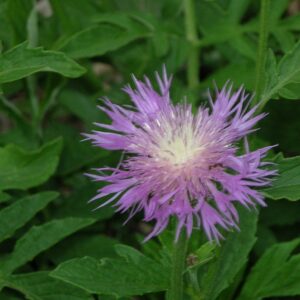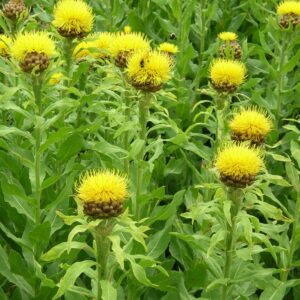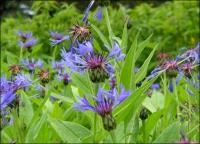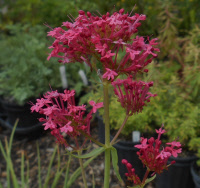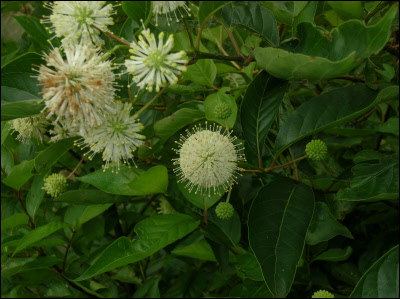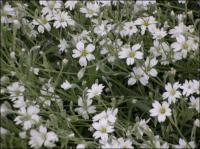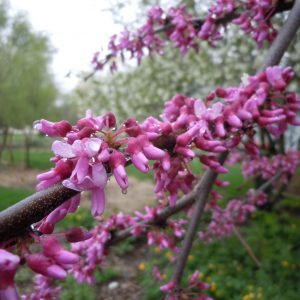Our Plants
Showing 121–128 of 587 results
-
Centaurea atropurpurea Red knapweed Z 5-9
Ruby-red to merlot, soft thistle-like blooms June-August, if deadheaded, atop silvery, deep cut foliage, rare.
OUT OF STOCK
Ruby-red to merlot, soft thistle-like blooms June-August, repeating if deadheaded, atop silvery, deep cut foliage, rare.
Size: 4’ x 2’
Care: sun in moist well-drained to well-drained soil
Native: meadows of Carpathian mountains
Wildlife Value: Deer resistantCentaurea named for the Centaur, half-horse and half-man who was a mythical healer. Red knapweed described by French entomologist Guillaume Antoine Olivier (1756-1814). Grown at America’s 1st botanic garden, Elgin Botanic Garden 1811.
-
Centaurea dealbata Persian cornflower Z 3-8
Rosy dome shaped blossoms with fringed petals May-June, deadhead for rebloom
Rosy dome shaped blossoms with fringed petals May-June, deadhead for rebloom
Size: 2-3' x 2'
Care: sun in moist well-drained soil
Native: CaucasusNamed for the Centaur, half-horse and half-man who was a mythical famous healer. This species collected before 1803.
-
Centaurea macrocephala Armenian basketflower, Globe centaurea Z 3-9
Picture a Canada thistle at its peak –this looks like a magnificent, cheerful yellow version – but it’s not a thistle July-August.
Picture a Canada thistle at its peak -this looks like a magnificent, cheerful yellow version – but it’s not a thistle. July-August
Can not ship to: Maryland and Washington
Size: 3-4' x 18-24"
Care: sun in well-drained to moist well-drained soil
Native: CaucasusCentaurea is named after the Greek mythological figure a Centaur named Chiron, half-horse, half-man. Macrocephala means “big-head” referring to the big flowers. Philadelphia nurseryman McMahon sent this to Jefferson in 1812.
-
Centaurea montana Mountain bluet, Blue bottle, Bachelor’s button Z 3-8
True blue, with a touch of pink near the center, spidery flowerheads in May-June and sporadically thereafter or all summer if you deadhead.
True blue, with a touch of pink near the center, spidery flowerheads in May-June and sporatically thereafter or all summer if you deadhead.
Size: 18" x 24"
Care: Sun - part shade, moist well-drained soil.
Native: Mountains of EuropeCentaurea is named after the Greek mythological figure, a Centaur named Chiron, half-horse, half-man. Ovid claimed that the plant cured a wound in Chiron’s foot from an arrow hurled by Hercules. Introduced from the Pyrenees and grown in English cottage gardens since the 1500’s.
-
Centranthus ruber Jupiter’s beard, Red Valerian, Pretty Betsy Z 5-8
Clusters of crimson, star-shaped florets atop 2’ stems bloom their heads off ALL summer into fall.
Clusters of crimson, star-shaped florets atop 2’ stems bloom their heads off ALL summer into fall.
Size: 24-36”x 12”
Care: Sun in well-drained alkaline soil, drought tolerant
Native: Mediterranean
Wildlife Value: attracts butterflies, bees and hover flies.Centranthus is from the Greek meaning “spurred flower.” According to Culpepper, an English herbalist from the early 1600’s, this plant comforts the heart and stirs up lust. Parkinson, in 1629 describes it “of a fine red colour, very pleasant to behold.”
-
Cephalanthus occidentalis Button bush, Honey balls Z 4-10
Perfectly round, white flowers perfume the air in Aug. & Sept. Red leaf stems contrast with green foliage.
Perfectly round, white flowers perfume the air in Aug. & Sept. Red leaf stems contrast with green foliage. Ships only in spring
Size: 6' x 8'
Care: Full sun to part shade in wet to moist well-drained soil
Native: New Brunswick S. to Fla. W. to CA.
Wildlife Value: Important shrub to maintain water quality and for wildlife habitat. Its roots absorb nutrients in water and reduce erosion along water's edges. Flowers attract butterflies. Birds nest in branches.Many medicinal uses for several tribes – Chickasaw, Choctaw, Kiowa, Meskwaki and Seminole, believed to remedy sore eyes, toothaches, dysentery, hemorrhages, headaches, nausea, fevers, constipation, ailments in horses and “wolf ghost sickness.” Rand 1866: “Valuable for blooming at a season when the shrubbery is bare of flowers.” Offered for sale in Bartram Garden’s 1783 Broadside, America’s 1st plant catalog.
**LISTED AS OUT OF STOCK BECAUSE WE DO NOT SHIP THIS ITEM. IT IS AVAILABLE FOR PURCHASE AT OUR RETAIL LOCATION.
-
Cerastium biebersteinii Mouse ear Z 4-7
White felt-like foliage, white flowers in spring. “Ornamental foliage dwarf plant with beautiful silvery tinted foliage,” Bliss & Sons Catalog 1872.
White felt-like foliage, white flowers in spring. “Ornamental foliage dwarf plant with beautiful silvery tinted foliage,” Bliss & Sons Catalog 1872.
Size: 6" x spreading
Care: Sun in well-drained soil
Native: TauriaCerastium is from the Greek keras meaning “horn” because of the shape of the seed capsule. Used as a groundcover under tropical plants in Victorian gardens. In 1913 Sanders identified it as a “good edging or rockery plant.” Grown in American gardens since 1860’s.
-
Cercis canadensis Red bud, Judas tree. Z 4-8
In spring when we need a Dionysian jolt from winter’s hibernation the Red bud’s flowers burst open. Shameless fuchsia buds appear along the tree’s stems, before the leaves unfurl. As spring turns to summer, glossy medium green hearts, the shape of each leaf, replace the buds. Vase shaped, fast growing and blooming as a young tree.
OUT OF STOCK
In spring when we need a Dionysian jolt from winter’s hibernation shameless fuchsia buds appear along the tree’s stems, then Red bud’s flowers burst open before the glossy leaves unfurl.
Size: 20-30’ tall and 25-35’ wide
Care: sun to part shade and moist well drained soil.
Native: between NY northwest to Wisconsin, Florida and southwest to New Mexico. Oklahoma adopted it as its state tree.
Wildlife Value: Spring Azure, Henry’s Elfin & Great Purple Hairstreak butterflies drink flowers’ nectar. Immune to the toxin Juglone from Walnut trees.1st described by French explorer and botanist Joseph Pitton Tournefort in 1700 in Institutiones rei herbariae and he named it Siliquastrum canadense. The tree went through six different names until 1737 when Linnaeus renamed it Cercis canadensis. Collected by Colonial nurseryman John Bartram. (1699-1776) George Washington planted this at Mount Vernon. Cherokee and Delaware steeped Red bud roots and bark in water for cures of fever, stuffiness, whooping cough and vomiting. Cherokee children ate the flowers. French Canadians added them to salads.


